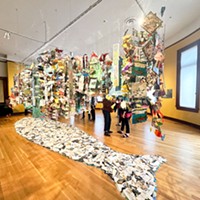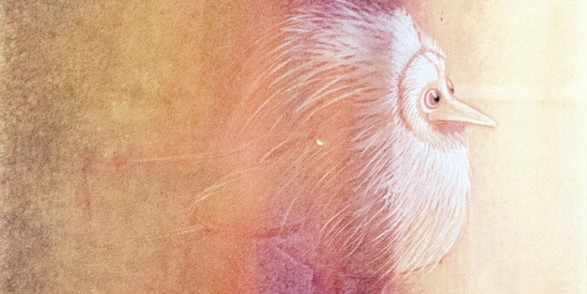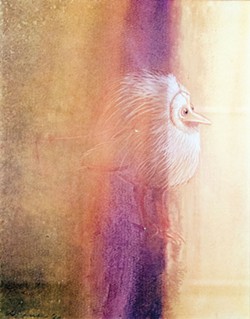Caged Birds Sing
Reproductions of prints by Morris Graves at the Morris Graves Museum of Art
By Gabrielle Gopinath[
{
"name": "Top Stories Video Pair",
"insertPoint": "7",
"component": "17087298",
"parentWrapperClass": "fdn-ads-inline-content-block",
"requiredCountToDisplay": "1"
}
]
It is easy to be enchanted by the calligraphic grace with which Morris Graves captures the nuance of a bird's posture. Looking at the print or drawing that results, you discover not just how the feathers are patterned but also how that creature scampers, waddles, barges or hops through the world. In "Hibernation I," Graves needs only a single purling stroke to render the curl of a sleeping ferret's tail in a way that is entirely compelling and plausible.
Twenty reproductions of Graves' prints are on view at the Morris Graves Museum of Art this month. The prints, drawn from different suites and bodies of work, date from the 1940s through the late 1960s. Most depict birds or animals. Grouped on facing walls with no timeline or contextualizing information, they illustrate a range of response to what nature-loving Graves consistently described as the baleful advent of the modern machine age.
Graves' bouncy, flexible line, often swiped across the page with a Chinese or Japanese calligraphy brush, articulates a fluent shorthand that abstracts or implies contours and surfaces, instead of describing them.
In "Spirit Bird" from 1954, the avian protagonist floats in a void of unstructured light. "Machine Age Noise" from 1957, with its angry, high-velocity ink splatters delivered from on high, rages mightily against the machine in a way that might surprise those who know Graves' work primarily in terms of his late-life paintings of exquisite, airless floral arrangements.
Graves observed animals and birds carefully, often depicting them with a tenderness suggesting recognition. The creatures that populate his bestiary are shown in a way that acknowledges a reciprocal spark of inner life or consciousness. And yet, the artist's gifts as a painter of birds and animals should not obscure the universality of his concerns. Nature, as such, was not his beat. Inner space interested him more.
Birds and animals served Graves as many things: avatars and talismans, mirrors, megaphones and spirit vessels. They embodied his shamanistic or animist belief system, which was influenced by Vedic scripture, Zen Buddhism and Native American spirituality, and founded on the premise that all of nature is imbued with spirit.
The bird and animal subjects in Graves' prints and drawings are doubly abstracted, not just in the sense that their contours are condensed and refined but also in the sense that they are are excised from their original sites and imported into strange new spaces. These venues are nebulous glowing voids for the most part, fraught with obscure dangers, where birds may be tangled in webs or pierced with shafts of light or trapped in cages behind dimly gleaming metal bars.
Ravens, owls and wounded Western Gulls might have been the avatars he selected, the bird spirits he had ready to hand. But Graves wasn't really interested in depicting the outside world. He was preoccupied with what he liked to call the vision of the inner eye. Like other expressionist animal painters (Franz Marc, Kiki Smith), he must have become alert early on to the fact that birds and animals could function as powerful conduits for empathy. The spectacle of the caged or suffering creature is a central theme in Graves' art; the earliest work here, "Emergence," made in 1944, shows a fragmented raven trapped within a glowing gridiron or crucible in an otherwise darkened void.
Like the post-war British expressionists Francis Bacon and Graham Sutherland, who were his almost exact contemporaries, Graves sought to engage viewers' empathy through the staged spectacle of suffering. Unlike Graves, Bacon and Sutherland were primarily painters of the human figure; like him, their response to the 20th century found expression in visions of suffering protagonists confined within claustrophobic, rationalized modern spaces.
As the musician and performance artist Laurie Anderson once put it, the soul is a bird. The animals and birds who get trapped and caged in Graves' pictures are avatars for the human spirit, pinched and constrained by what Graves understood to be the soul-destroying automation, alienation and noise of modern times. Perhaps it's just as well he didn't live to experience the Internet.
It would be wonderful to see a serious show of Graves' art return to the walls of the museum that bears his name. To be clear, this display of reproduction prints is not that show. While it is regrettable that original works of art were apparently not available for display, it is also disappointing to see inadvertently misleading exhibition wall labels that fail to acknowledge reproduction copies of Graves' art as such. The artist, and the public, deserve better. And yet, this exhibition whets the appetite for more.
Speaking of Morris Graves Museum Of Art
-

Music Today: Sunday, Feb. 18
Feb 18, 2024 -

Truth Units
Sep 7, 2023 -

The Return of '30,000 Salmon'
Aug 17, 2023 - More »
more from the author
-
Nancy Tobin's CRy-Baby Installation at CR
- Feb 22, 2024
-
Truth Units
Bachrun LoMele's Burn Pile/The Andromeda Mirage at the Morris Graves
- Sep 7, 2023
-
Ruth Arietta's Illusory Interiors at Morris Graves Museum of Art
- Aug 10, 2023
- More »

































